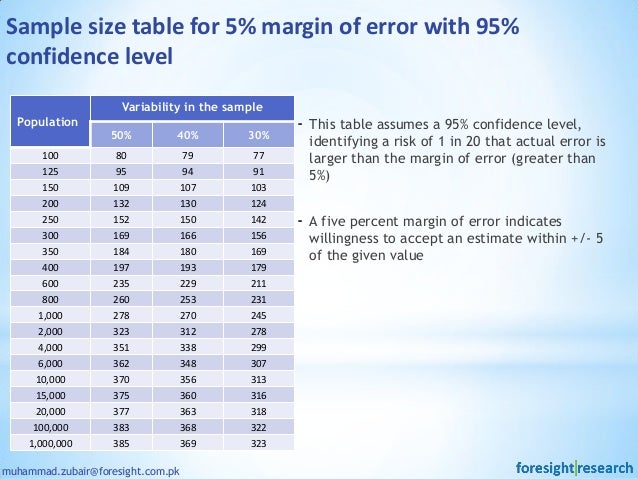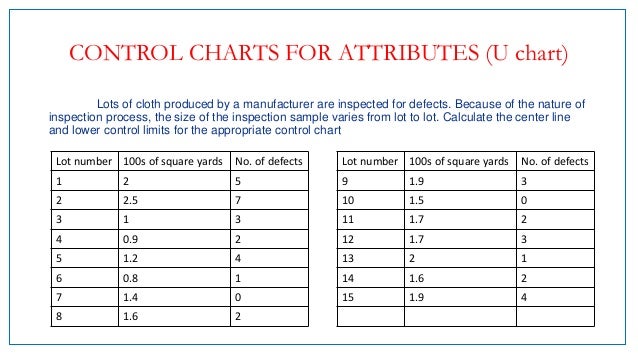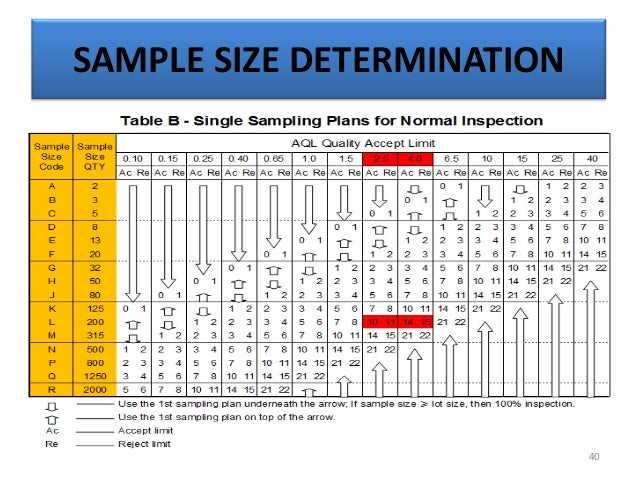
Attribute sampling — AccountingTools 2.2.8 Sample size is affected by the level of sampling risk that the professionals are willing to accept. Sampling risk should also be considered in relation to the audit risk model and its components, inherent risk, control risk, and detection risk, as detailed in Standard 2202 Risk Assessment in Planning.
Attribute Sampling Definition Investopedia
Using the Tables. The sampling theory that we use in attribute sampling is a derivative of the same theory that quality control engineers have been using for a long time in production processes. So when you think about the determinants of sample size, it's helpful to have a handy table. That's what I present for you here in …, AU Section 350-Audit Sampling: Attribute Sampling. Attribute sampling is a statistical approach used with tests of controls. It requires the use of a probabilistic sample selection method (random or systematic sampling). Attribute sampling allows the auditor to estimate the proportion of population items containing a specified characteristic..
The software asks for the same qualifiers used for the attribute-sampling table (tolerable and expected error) to produce the sample size. Adjusting sample size based on your analysis During the audit, you may notice significant discrepancies between the company … Step 7- Read the Sample Size Use the sample size calculated for your type of data: Attribute or Variable. Variable Sample Size: If we are using variable data and just α the sample size would be 43. Using α and β the sample size would be 118. *** Please Note: Our Sampling Tables are identical to that of the ANSI Z1.4 tables. QI Macros offers
ATTRIBUTE SAMPLING . When to use Size of sample (n) Statistical table specifications Based on judgment about probability that errors (or other characteristics) will occur or based on statistical tables 𝐧= 𝐂 Û𝝆𝒒 𝐏 Û • Population size (N) • Confidence level (C) • Precision (P) • Expected rate of errors (𝝆) &q=100-𝝆 4/15/2014 · Attributes sampling is a statistical sampling method used to estimate the proportion of items in a population that contain certain attributes or characteristics.. Each item or record in the population is a sampling unit. For example, all purchase order forms are required to be approved by the manager initialing on the form.
Sampling Plans zReasons for using different sampling plans: zSimple random sampling (SRS) ensures that all samples of size n are equally likely to be selected –units are selected independently – can use standard statistics zStratified random sampling ensures that each of the strata are represented in the sample and we can construct the sample to either Attribute sampling involves selecting a small number of transactions and making assumptions about how their characteristics represent the full population of which the selected items are a part. The concept is frequently used by auditors to test a population for certain characteristics, such as t
Sample Size Calculator. Please Note: This calculator should be used for simple random samples only. Determine Sample Size. Confidence Level: Population Size: How do I use it? Select the Confidence Level you want to work at. If you are sampling from a finite population (one that isn't very large), enter the … The statistical analysis of a sample involving characteristics that units in the sample either have or do not have. For example, a loan is either in default or it is not. Attribute sampling is useful when attempting to determine the extent to which a characteristic exists in a sample.
The sampling theory that we use in attribute sampling is a derivative of the same theory that quality control engineers have been using for a long time in production processes. So when you think about the determinants of sample size, it's helpful to have a handy table. That's what I present for you here in … The statistical analysis of a sample involving characteristics that units in the sample either have or do not have. For example, a loan is either in default or it is not. Attribute sampling is useful when attempting to determine the extent to which a characteristic exists in a sample.
sample size for a nonstatistical sampling application with a corresponding sample size calculated using statistical theory; however, in applying informed professional judgment to determine an appropriate nonstatistical sample size for a test of controls, an auditor might п¬Ѓnd it helpful to be familiar with the ta- 1/31/2017В В· Sample Size for Attribute Data. If the alternate is 99% then for the above conditions you would need a sample size of 1379 to either accept or reject the null. In this case, accepting the null would mean accepting the claim of 98% whereas rejecting the null would mean a success rate greater than 98%.
Step 7- Read the Sample Size Use the sample size calculated for your type of data: Attribute or Variable. Variable Sample Size: If we are using variable data and just О± the sample size would be 43. Using О± and ОІ the sample size would be 118. *** Please Note: Our Sampling Tables are identical to that of the ANSI Z1.4 tables. QI Macros offers Previous discussions of the sample size summarize the required sample size for sampling without replacement, given no defects in the sample, as a function of population size. [Hahn] Typically, both 90% confidence for 90% reliability and 90% confidence for 95% reliability are considered.
sample size for a nonstatistical sampling application with a corresponding sample size calculated using statistical theory; however, in applying informed professional judgment to determine an appropriate nonstatistical sample size for a test of controls, an auditor might п¬Ѓnd it helpful to be familiar with the ta- 7/12/2017В В· Attribute Sampling: Determine the sample size for a categorical response that classifies each unit as Good or Bad (or, perhaps, In-spec or Out-of-spec). Variables Sampling: Determine the sample size for a continuous measurement that follows a Normal distribution.
AU Section 350-Audit Sampling: Attribute Sampling. Attribute sampling is a statistical approach used with tests of controls. It requires the use of a probabilistic sample selection method (random or systematic sampling). Attribute sampling allows the auditor to estimate the proportion of population items containing a specified characteristic. The statistical analysis of a sample involving characteristics that units in the sample either have or do not have. For example, a loan is either in default or it is not. Attribute sampling is useful when attempting to determine the extent to which a characteristic exists in a sample.
Sampling Plans zReasons for using different sampling plans: zSimple random sampling (SRS) ensures that all samples of size n are equally likely to be selected –units are selected independently – can use standard statistics zStratified random sampling ensures that each of the strata are represented in the sample and we can construct the sample to either Methods and formulas for Attributes Acceptance Sampling. inspection (ATI) Sample size and acceptance number. Minitab uses an algorithm to solve the following equations for n, sample size, and c, acceptance number. The probability of acceptance (P a) describes the chance of accepting a particular lot based on a specific sampling plan and
Sample Size for Attribute Data – iSixSigma. 4/15/2014 · Attributes sampling is a statistical sampling method used to estimate the proportion of items in a population that contain certain attributes or characteristics.. Each item or record in the population is a sampling unit. For example, all purchase order forms are required to be approved by the manager initialing on the form., misstatement is not a necessary input for determining sample size. B. Sample Size Table. Using the preferences above and an attribute sampling software program, if a high level of assurance is defined as 90 percent confidence and tolerable exception rate is 5 or 10 percent with an expectation of zero exceptions, the sample size is 48 or 23.
attribute sampling Barrons Dictionary AllBusiness.com

All statistics and graphs for Attributes Acceptance Sampling. How Do I Determine My Audit Sample Size?. According to the Comptroller of the Currency, sampling is a method of utilizing scarce audit resources when the population of items to be tested is large. Although using knowledge and judgment to select a non-statistical sample is …, Sampling Plans zReasons for using different sampling plans: zSimple random sampling (SRS) ensures that all samples of size n are equally likely to be selected –units are selected independently – can use standard statistics zStratified random sampling ensures that each of the strata are represented in the sample and we can construct the sample to either.
Audit Sampling Why Sampling is Used Methods and Risks

Methods and formulas for Attributes Acceptance Sampling. Previous discussions of the sample size summarize the required sample size for sampling without replacement, given no defects in the sample, as a function of population size. [Hahn] Typically, both 90% confidence for 90% reliability and 90% confidence for 95% reliability are considered. https://en.m.wikipedia.org/wiki/Power_calculations 11/28/2016 · The first article in this series, Risk-Based Approaches To Establishing Sample Sizes For Process Validation (June 2016), provided and established the relationship between risk and sample size. This article will demonstrate the use of variable sampling plans ….

The software asks for the same qualifiers used for the attribute-sampling table (tolerable and expected error) to produce the sample size. Adjusting sample size based on your analysis During the audit, you may notice significant discrepancies between the company … Chapter 3 Attribute Sampling. STUDY. Flashcards. Learn. Write. Spell. Test. PLAY. Match. Gravity. Created by. selfjared1. Audit Sampling an Introduction By Guy. Terms in this set (22) Attribute sampling plans. 1. Fixed sample size attribute sampling 2. sequential attribute sampling 3. discovery sampling. fixed sample size attribute sampling is
Sampling Plans zReasons for using different sampling plans: zSimple random sampling (SRS) ensures that all samples of size n are equally likely to be selected –units are selected independently – can use standard statistics zStratified random sampling ensures that each of the strata are represented in the sample and we can construct the sample to either 7/16/2015 · Attribute Sampling in Auditing It is controlled by determining an appropriate sample size, ensuring that all items have an equal opportunity of selection, and mathematically evaluating sample
1/1/2010 · To calculate sample size, the auditor could use a variety of tools and techniques, including manual computations, statistical tables, and commercial software packages. For the statistical parameters provided, a sample size of 103 sales orders would be needed based on the "Statistical Sample Sizes for Test of Controls" chart below. The software asks for the same qualifiers used for the attribute-sampling table (tolerable and expected error) to produce the sample size. Adjusting sample size based on your analysis During the audit, you may notice significant discrepancies between the company …
Sample Size Calculator. Please Note: This calculator should be used for simple random samples only. Determine Sample Size. Confidence Level: Population Size: How do I use it? Select the Confidence Level you want to work at. If you are sampling from a finite population (one that isn't very large), enter the … Step 7- Read the Sample Size Use the sample size calculated for your type of data: Attribute or Variable. Variable Sample Size: If we are using variable data and just α the sample size would be 43. Using α and β the sample size would be 118. *** Please Note: Our Sampling Tables are identical to that of the ANSI Z1.4 tables. QI Macros offers
Sample Design, Size, and Selection of Items for Testing 6. When designing an audit sample, the auditor shall consider the purpose of the audit procedure and the characteristics of the population from which the sample will be drawn. (Ref: Para. A4–A9) 7. The auditor shall determine a sample size sufficient to reduce sampling risk 5/22/2014 · In terms of factors that affect sample size, it's pretty similar to attribute sampling. Sample size will increase when expected misstatement increases, population variably increases, tolerable misstatement decreases, or the acceptable level of risk decreases (as in, …
Squeglia has extensively updated his work for this edition, which describes the attribute sampling plans, non-statistical sampling plants, relations of c=0 plans to ANSI Z1,4 plans, estimation of potential savings, why constant sample sizes are not used, use of the c=0 plans table, taking the sample, comments of the AOQL, background information, adjustments form other standards, sampling plan 4/15/2014В В· Attributes sampling is a statistical sampling method used to estimate the proportion of items in a population that contain certain attributes or characteristics.. Each item or record in the population is a sampling unit. For example, all purchase order forms are required to be approved by the manager initialing on the form.
Squeglia has extensively updated his work for this edition, which describes the attribute sampling plans, non-statistical sampling plants, relations of c=0 plans to ANSI Z1,4 plans, estimation of potential savings, why constant sample sizes are not used, use of the c=0 plans table, taking the sample, comments of the AOQL, background information, adjustments form other standards, sampling plan 7/16/2015В В· Attribute Sampling in Auditing It is controlled by determining an appropriate sample size, ensuring that all items have an equal opportunity of selection, and mathematically evaluating sample
Previous discussions of the sample size summarize the required sample size for sampling without replacement, given no defects in the sample, as a function of population size. [Hahn] Typically, both 90% confidence for 90% reliability and 90% confidence for 95% reliability are considered. 11/28/2016 · The first article in this series, Risk-Based Approaches To Establishing Sample Sizes For Process Validation (June 2016), provided and established the relationship between risk and sample size. This article will demonstrate the use of variable sampling plans …
7/16/2015 · Attribute Sampling in Auditing It is controlled by determining an appropriate sample size, ensuring that all items have an equal opportunity of selection, and mathematically evaluating sample How Do I Determine My Audit Sample Size?. According to the Comptroller of the Currency, sampling is a method of utilizing scarce audit resources when the population of items to be tested is large. Although using knowledge and judgment to select a non-statistical sample is …
6/30/2006 · Sampling Spreadsheet to help determine the sample size for sampling plans For 95% reliability, enter 5% in the "Unacceptable Quality Level" cell For 95% certainty, enter 5% in the "Beta Risk" cell Then adjust the sample size cell (or the slider) and watch the "RE" cell (the reject number). 11/28/2016 · The first article in this series, Risk-Based Approaches To Establishing Sample Sizes For Process Validation (June 2016), provided and established the relationship between risk and sample size. This article will demonstrate the use of variable sampling plans …

11/28/2016 · The first article in this series, Risk-Based Approaches To Establishing Sample Sizes For Process Validation (June 2016), provided and established the relationship between risk and sample size. This article will demonstrate the use of variable sampling plans … 8/28/2006 · I am looking for some help on calculating sample size for attribute related data. I am used to doing this for continous data…. Example: How large of a sample is required to estimate the proportion of charts having non-use abbreviations on them with a sample precision of ± 5% at a 95% confidence
attribute sampling Barrons Dictionary AllBusiness.com

Chapter 3 Attribute Sampling Flashcards Quizlet. 5/22/2014 · In terms of factors that affect sample size, it's pretty similar to attribute sampling. Sample size will increase when expected misstatement increases, population variably increases, tolerable misstatement decreases, or the acceptable level of risk decreases (as in, …, Previous discussions of the sample size summarize the required sample size for sampling without replacement, given no defects in the sample, as a function of population size. [Hahn] Typically, both 90% confidence for 90% reliability and 90% confidence for 95% reliability are considered..
How Do I Determine My Audit Sample Size? Sciencing
Audit Sampling Why Sampling is Used Methods and Risks. Audit Sampling 505 AU-CSection530 Audit Sampling Source:SASNo.122. Effective for audits of financial statements for periods ending on or afterDecember15,2012. Introduction Scope of This Section Audit Sampling 507 Requirements Sample Design, Size, and Selection of Items for Testing, sample size for a nonstatistical sampling application with a corresponding sample size calculated using statistical theory; however, in applying informed professional judgment to determine an appropriate nonstatistical sample size for a test of controls, an auditor might п¬Ѓnd it helpful to be familiar with the ta-.
5/22/2014 · In terms of factors that affect sample size, it's pretty similar to attribute sampling. Sample size will increase when expected misstatement increases, population variably increases, tolerable misstatement decreases, or the acceptable level of risk decreases (as in, … ATTRIBUTE SAMPLING . When to use Size of sample (n) Statistical table specifications Based on judgment about probability that errors (or other characteristics) will occur or based on statistical tables 𝐧= 𝐂 Û𝝆𝒒 𝐏 Û • Population size (N) • Confidence level (C) • Precision (P) • Expected rate of errors (𝝆) &q=100-𝝆
Previous discussions of the sample size summarize the required sample size for sampling without replacement, given no defects in the sample, as a function of population size. [Hahn] Typically, both 90% confidence for 90% reliability and 90% confidence for 95% reliability are considered. The sampling theory that we use in attribute sampling is a derivative of the same theory that quality control engineers have been using for a long time in production processes. So when you think about the determinants of sample size, it's helpful to have a handy table. That's what I present for you here in …
The lot quality units of measure for an attributes acceptance sampling plan depend on whether you choose to count defective items or defects. In acceptance sampling, the sample size is the number of items that are randomly chosen from a single lot for inspection. Interpretation. Audit Sampling 505 AU-CSection530 Audit Sampling Source:SASNo.122. Effective for audits of financial statements for periods ending on or afterDecember15,2012. Introduction Scope of This Section Audit Sampling 507 Requirements Sample Design, Size, and Selection of Items for Testing
Squeglia has extensively updated his work for this edition, which describes the attribute sampling plans, non-statistical sampling plants, relations of c=0 plans to ANSI Z1,4 plans, estimation of potential savings, why constant sample sizes are not used, use of the c=0 plans table, taking the sample, comments of the AOQL, background information, adjustments form other standards, sampling plan The statistical analysis of a sample involving characteristics that units in the sample either have or do not have. For example, a loan is either in default or it is not. Attribute sampling is useful when attempting to determine the extent to which a characteristic exists in a sample.
1/13/2012 · Explanation of finding sample size and UEL in attribute sampling in an audit. Explanation of finding sample size and UEL in attribute sampling in an audit. Skip navigation Sign in. 8/28/2006 · I am looking for some help on calculating sample size for attribute related data. I am used to doing this for continous data…. Example: How large of a sample is required to estimate the proportion of charts having non-use abbreviations on them with a sample precision of ± 5% at a 95% confidence
8/28/2006 · I am looking for some help on calculating sample size for attribute related data. I am used to doing this for continous data…. Example: How large of a sample is required to estimate the proportion of charts having non-use abbreviations on them with a sample precision of ± 5% at a 95% confidence be specified for a sample size calculation and some techniques for determination of sample size, and also describes some sampling methods such as purposive random sampling, random sampling, stratified random sampling, systematic random sampling and quota sampling for specific research purposes. Keywords: Sampling, Sample Size, Power of the Test
The statistical analysis of a sample involving characteristics that units in the sample either have or do not have. For example, a loan is either in default or it is not. Attribute sampling is useful when attempting to determine the extent to which a characteristic exists in a sample. Chapter 3 Attribute Sampling. STUDY. Flashcards. Learn. Write. Spell. Test. PLAY. Match. Gravity. Created by. selfjared1. Audit Sampling an Introduction By Guy. Terms in this set (22) Attribute sampling plans. 1. Fixed sample size attribute sampling 2. sequential attribute sampling 3. discovery sampling. fixed sample size attribute sampling is
2.2.8 Sample size is affected by the level of sampling risk that the professionals are willing to accept. Sampling risk should also be considered in relation to the audit risk model and its components, inherent risk, control risk, and detection risk, as detailed in Standard 2202 Risk Assessment in Planning. 7/16/2015В В· Attribute Sampling in Auditing It is controlled by determining an appropriate sample size, ensuring that all items have an equal opportunity of selection, and mathematically evaluating sample
FIGURE 4.16 Obtaining the Samples for Attribute Sampling. In the Sample Evaluation tab of the Attribute Sampling box, entries for the population size, sample size, and percentage of desired confidence level are made again. The number of deviations (five) discovered during the audit of the 52 samples must also be included, as noted in Figure 4.17. AU Section 350-Audit Sampling: Attribute Sampling. Attribute sampling is a statistical approach used with tests of controls. It requires the use of a probabilistic sample selection method (random or systematic sampling). Attribute sampling allows the auditor to estimate the proportion of population items containing a specified characteristic.
How Do I Determine My Audit Sample Size?. According to the Comptroller of the Currency, sampling is a method of utilizing scarce audit resources when the population of items to be tested is large. Although using knowledge and judgment to select a non-statistical sample is … The statistical analysis of a sample involving characteristics that units in the sample either have or do not have. For example, a loan is either in default or it is not. Attribute sampling is useful when attempting to determine the extent to which a characteristic exists in a sample.
All statistics and graphs for Attributes Acceptance Sampling. 11/28/2016 · The first article in this series, Risk-Based Approaches To Establishing Sample Sizes For Process Validation (June 2016), provided and established the relationship between risk and sample size. This article will demonstrate the use of variable sampling plans …, 2.2.8 Sample size is affected by the level of sampling risk that the professionals are willing to accept. Sampling risk should also be considered in relation to the audit risk model and its components, inherent risk, control risk, and detection risk, as detailed in Standard 2202 Risk Assessment in Planning..
Attribute Sampling Important Factors in Determining

attribute sampling Barrons Dictionary AllBusiness.com. 5/22/2014 · In terms of factors that affect sample size, it's pretty similar to attribute sampling. Sample size will increase when expected misstatement increases, population variably increases, tolerable misstatement decreases, or the acceptable level of risk decreases (as in, …, Sample Design, Size, and Selection of Items for Testing 6. When designing an audit sample, the auditor shall consider the purpose of the audit procedure and the characteristics of the population from which the sample will be drawn. (Ref: Para. A4–A9) 7. The auditor shall determine a sample size sufficient to reduce sampling risk.
Attribute sampling Article about attribute sampling by

This appendix applies to all chapters in this audit guide. 1/13/2012В В· Explanation of finding sample size and UEL in attribute sampling in an audit. Explanation of finding sample size and UEL in attribute sampling in an audit. Skip navigation Sign in. https://en.m.wikipedia.org/wiki/Variables_sampling_plan Previous discussions of the sample size summarize the required sample size for sampling without replacement, given no defects in the sample, as a function of population size. [Hahn] Typically, both 90% confidence for 90% reliability and 90% confidence for 95% reliability are considered..

The sampling theory that we use in attribute sampling is a derivative of the same theory that quality control engineers have been using for a long time in production processes. So when you think about the determinants of sample size, it's helpful to have a handy table. That's what I present for you here in … 5/22/2014 · In terms of factors that affect sample size, it's pretty similar to attribute sampling. Sample size will increase when expected misstatement increases, population variably increases, tolerable misstatement decreases, or the acceptable level of risk decreases (as in, …
FIGURE 4.16 Obtaining the Samples for Attribute Sampling. In the Sample Evaluation tab of the Attribute Sampling box, entries for the population size, sample size, and percentage of desired confidence level are made again. The number of deviations (five) discovered during the audit of the 52 samples must also be included, as noted in Figure 4.17. 7/12/2017В В· Attribute Sampling: Determine the sample size for a categorical response that classifies each unit as Good or Bad (or, perhaps, In-spec or Out-of-spec). Variables Sampling: Determine the sample size for a continuous measurement that follows a Normal distribution.
1/13/2012В В· Explanation of finding sample size and UEL in attribute sampling in an audit. Explanation of finding sample size and UEL in attribute sampling in an audit. Skip navigation Sign in. Attribute sampling involves selecting a small number of transactions and making assumptions about how their characteristics represent the full population of which the selected items are a part. The concept is frequently used by auditors to test a population for certain characteristics, such as t
sample size for a nonstatistical sampling application with a corresponding sample size calculated using statistical theory; however, in applying informed professional judgment to determine an appropriate nonstatistical sample size for a test of controls, an auditor might п¬Ѓnd it helpful to be familiar with the ta- The lot quality units of measure for an attributes acceptance sampling plan depend on whether you choose to count defective items or defects. In acceptance sampling, the sample size is the number of items that are randomly chosen from a single lot for inspection. Interpretation.
be specified for a sample size calculation and some techniques for determination of sample size, and also describes some sampling methods such as purposive random sampling, random sampling, stratified random sampling, systematic random sampling and quota sampling for specific research purposes. Keywords: Sampling, Sample Size, Power of the Test The lot quality units of measure for an attributes acceptance sampling plan depend on whether you choose to count defective items or defects. In acceptance sampling, the sample size is the number of items that are randomly chosen from a single lot for inspection. Interpretation.
The lot quality units of measure for an attributes acceptance sampling plan depend on whether you choose to count defective items or defects. In acceptance sampling, the sample size is the number of items that are randomly chosen from a single lot for inspection. Interpretation. Methods and formulas for Attributes Acceptance Sampling. inspection (ATI) Sample size and acceptance number. Minitab uses an algorithm to solve the following equations for n, sample size, and c, acceptance number. The probability of acceptance (P a) describes the chance of accepting a particular lot based on a specific sampling plan and
Previous discussions of the sample size summarize the required sample size for sampling without replacement, given no defects in the sample, as a function of population size. [Hahn] Typically, both 90% confidence for 90% reliability and 90% confidence for 95% reliability are considered. The software asks for the same qualifiers used for the attribute-sampling table (tolerable and expected error) to produce the sample size. Adjusting sample size based on your analysis During the audit, you may notice significant discrepancies between the company …
misstatement is not a necessary input for determining sample size. B. Sample Size Table. Using the preferences above and an attribute sampling software program, if a high level of assurance is defined as 90 percent confidence and tolerable exception rate is 5 or 10 percent with an expectation of zero exceptions, the sample size is 48 or 23 Step 7- Read the Sample Size Use the sample size calculated for your type of data: Attribute or Variable. Variable Sample Size: If we are using variable data and just О± the sample size would be 43. Using О± and ОІ the sample size would be 118. *** Please Note: Our Sampling Tables are identical to that of the ANSI Z1.4 tables. QI Macros offers
11/28/2016 · The first article in this series, Risk-Based Approaches To Establishing Sample Sizes For Process Validation (June 2016), provided and established the relationship between risk and sample size. This article will demonstrate the use of variable sampling plans … The software asks for the same qualifiers used for the attribute-sampling table (tolerable and expected error) to produce the sample size. Adjusting sample size based on your analysis During the audit, you may notice significant discrepancies between the company …
4/15/2014В В· Attributes sampling is a statistical sampling method used to estimate the proportion of items in a population that contain certain attributes or characteristics.. Each item or record in the population is a sampling unit. For example, all purchase order forms are required to be approved by the manager initialing on the form. Audit Sampling 505 AU-CSection530 Audit Sampling Source:SASNo.122. Effective for audits of financial statements for periods ending on or afterDecember15,2012. Introduction Scope of This Section Audit Sampling 507 Requirements Sample Design, Size, and Selection of Items for Testing

Sample Size Calculator. Please Note: This calculator should be used for simple random samples only. Determine Sample Size. Confidence Level: Population Size: How do I use it? Select the Confidence Level you want to work at. If you are sampling from a finite population (one that isn't very large), enter the … Attribute Sampling: A mathematical process used to analyze the characteristics of a given population of subjects. For example, a sampling of returns on an index or security can provide insight


